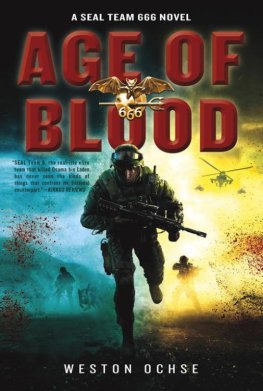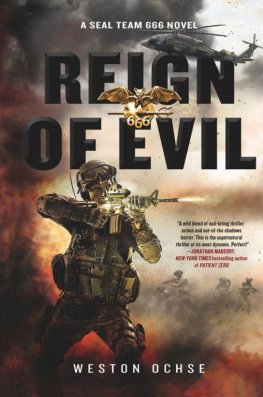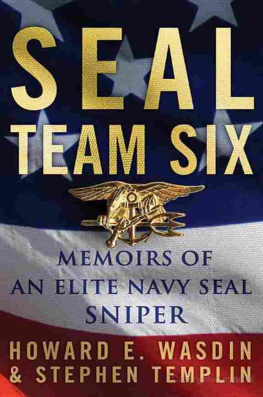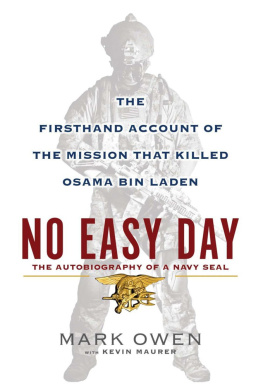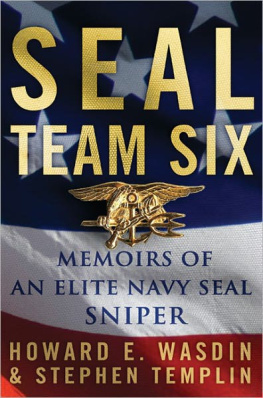Weston Ochse
SEAL Team 666

Many people helped to make the book youre holding (or viewing or listening to) and I owe them all a sincere thanks. Thanks first to Brendan Deneen for his trust; and to think I almost passed up the email because I thought it was another Bin Laden gag photo. Thanks also to Peter Joseph, Margaret Smith, Nicole Sohl and the rest of the Thomas Dunne/St. Martins Press Team, including Tweetmaster Paul. Thanks to Thirdy Lopez for your invaluable Tagalog language help and to Chris Fulbright for the hookup. Thanks to Ma Tai Tai for teaching me Chinese. Some of it stuck. Thanks to Dick Couch and Mir Bahmanyar, whose work I relied on for my initial research, as well as all my friends on the teams. You know who you are, especially Brian and Tommy. My gratitude includes Drew Williams for early reading, Dave Lake for a solid heart, Brian Wallenius for a solid ear, and Eunice and Greg Magill for your invaluable reconnaissance. Thanks of course to my agent, Robert Fleck. Shout-out to the bands Justice, Creed, the Eagles of Death Metal, Guns and Roses, and QOTSA for rocking me through the writing process. And thanks most of all to Yvonne, without whose support, wisdom, and love none of this would be possible.
EARLY MORNING. PAKISTAN. MAY 2, 2011.
DONT TRY THIS AT HOME was stenciled on the side of the first of two Blackhawk helicopters assigned to the 160th Special Operations Aviation Regiment, aka Night Stalkers. They were en route from Jalalabad Air Base in Afghanistan to the sleepy residential section of Abbottabad, Pakistan, where a million-dollar compound rested a mere eight hundred meters from Kakul military academy, one of Pakistans premiere army officer training schools.
SEAL Team 666 rode in the first helicopter. Comprising only five men and a dog, they were different in form and function from all other special-operations units. They wore black camouflage fatigues with dark gray Rhodesian combat vests. On their heads were Protec skate helmets modified for multiband inter/intra team radio (MBITR) headsets and microphones. Atop each helmet was a mount that held a pair of night-vision goggles (NVG). All but one of the SEALs wore gray ballistic face masks. Designed to protect the wearer from 9mm and shotgun hits, the masks produced a likeness similar to a hockey goalies.
On board the second helicopter, eleven members of SEAL Team 6 were ready to provide backup if necessary. Dressed similarly to the SEAL team in the first helicopter, none of them wore face masks and they did not have a dog.
Five minutes, the pilot announced over the radio system. The crew chief and his gunner prepared the doors and checked the M60 machine guns they could employ if necessary.
SEAL Team 666 heard the announcement through the MBITR and performed a last-minute weapons check. All five SEALs carried SIG Sauer 9mm automatic pistols. In addition to the 9s, two SEALs carried Heckler & Koch (HK) MP5s, two SEALs carried M4 Super 90 semiautomatic 12-gauge shotguns, and the fifth SEAL carried a Stoner SR-25 sniper rifle.
The dog was a Belgian Malinois and lay panting at the feet of the sniper, her mouth open in what could be considered the canine equivalent of an anticipatory grin. She wore a canine tactical assault vest. Spare ammo clips were tucked into compartments, as was a first-aid kit. The word HOOVER was stitched across the back of the vest.
SEALs lowered the NVGs into place, turned them on, and watched the world transform into a realm of phantom green. They postured, ready to deploy through the side doors. The dog stood, prepared to leave last.
The Blackhawks doors opened, letting in the cool Pakistani mountain air. The triangular compound came into sight in the SEALs green-tinged vision. The Blackhawk was coming in fast, just beginning to flare. But as the helicopter passed over and started to land, the green vision flashed white and all systems blacked out.
Hold on, shouted the pilot. Were going down.
Force field, grunted one of the SEALs. Does it every time.
The SEALs held on to the static bars affixed to the ceiling and ripped their NVGs free, now useless since the force field had fried the electronics.
The pilot managed to autorotate the Blackhawk to a clear piece of ground outside the twelve-foot wall skirting the compound. The other helicopter landed nearby, steering clear of what took down the lead chopper.
One member of SEAL Team 666 vaulted out of the Blackhawk and placed a shape charge on the wall. He stepped aside while a man-sized hole blew through it with a dull whump. Then the two SEALs with the HKs deployed into the breach, weapons sunk deep into their shoulders, barrels leading the way. The SEALs with the shotguns came next, followed by the sniper and the dog.
The sniper set up in a corner of the yard where he had a field of fire that included the main entrance to the compound, the front door, and windows on all three floors. Outside the wall, SEAL Team 6 would ensure that no one got in, especially if anyone was planning on coming to the rescue of those they were about to kill. Ultimately, it was up to the sniper to ensure that no one got out. Hoover waited with him until the others gave the all-clear.
The other four slammed through the front door, pouring through in a routine that had been drilled into them so many times it had become second nature. Every corner of the entry room was controlled by the four SEALs and their weapons. When a bleary-eyed guard stepped into the room from a hallway, a 12-gauge slug disintegrated his face. The sound of the explosion in the tight quarters was stunning, but a thousand hours of close-quarters battle (CQB) training enabled the SEALs to ignore it.
With the communications gear fried as well, they had to resort to hand signals. The fact that the gear no longer worked meant two things, however. One, it meant that the monitoring from the White House Situation Room, Coronado, Dam Neck, and a dozen other places could no longer be conducted, meaning any chance of a flag officer or politician trying to use a ten-thousand-mile screwdriver to fix something they didnt like was impossible. And two, it meant that their target was most likely here, unless someone else had the capability of constructing a force field large enough to make a platoons worth of twenty-first-century electronics worthless.
One of the SEALs made a hand motion to the sniper and Hoover. The sniper returned the gesture and spoke a few words. The dog shot across the ground until she was inside and with the SEALs.
They cleared the first floor, shot three more guards, and cut the power and telephone lines.
The two SEALs with the MP5s stacked up the stairs. They paused at the landing between the first and second floors. A hand signal to the others indicated there was a door at the top. After ensuring the stairs werent booby-trapped, the lead SEAL gestured for Hoover to check out the door. The dog padded silently up the stairs and sniffed at the space between the bottom of the door and the floor. It didnt take long for the dog to turn rigid, then glance worriedly at the SEAL beside her.
The SEAL gave a hand signal to the others. The other SEALs responded immediately, pressing themselves against the walls as they waited for the door to open. Then the SEAL gave another signal to the dog. They were now hair-trigger ready.
The SEAL posted nearest the door pointed his Super 90 toward the spot where the locking mechanism met the doorframe, then pulled the trigger three times. Amid the explosion of sound, light, and wooden splinters, he shoved the door open and flattened himself against the stairs.


